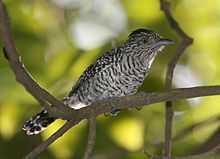Barred antshrike
| Barred antshrike | |
|---|---|
 | |
| Male in Goiás, Brazil. | |
| Conservation status | |
| Scientific classification | |
| Kingdom: | Animalia |
| Phylum: | Chordata |
| Class: | Aves |
| Order: | Passeriformes |
| Family: | Thamnophilidae |
| Genus: | Thamnophilus |
| Species: | T. doliatus |
| Binomial name | |
| Thamnophilus doliatus (Linnaeus, 1764) | |
The barred antshrike (Thamnophilus doliatus) is a passerine bird in the antbird family. It is found in the Neotropics from Tamaulipas, Mexico, through Central America, Trinidad and Tobago, and a large part of South America east of the Andes as far south as northern Argentina, Bolivia and Paraguay. There is one accepted record from southern Texas.[2] It is found in a wide range of wooded habitats (even gardens and parks) in both humid and arid regions. Throughout a large part of its range, it is among the most common antbirds.
Description
 |
Duet of pair from Carara National Park, Costa Rica
|
| Problems playing this file? See media help. | |
The barred antshrike is typically 16.5 cm (6.5 in) long, and weighs 25 g (0.88 oz). This species exhibits marked sexual dimorphism. The male is barred all over with black and white, and has a white-based black crest that is raised in display. The female is rufous above with a chestnut crest. The sides of her head and neck are streaked with black, and the underparts are rich buff. In both sexes, the legs are grey, the bill is black and the iris is pale yellow.
The subspecies vary primarily in the overall darkness and the amount of barring and hue of the underparts. For example, in the Tobagonian race T. d. tobagensis, males are whiter below, and females darker, than in the nominate subspecies. The most distinctive subspecies is T. d. capistratus of the Caatinga in north-eastern Brazil, where males have uniform black crown (no white barring to the base) and females have streaked throat and faintly barred belly. It is also the only subspecies where the iris is deep maroon-red. It has recently been suggested that it should be considered a separate species, the Caatinga barred antshrike.
Behavior
It is typically found as territorial pairs. The female lays two purple-marked creamy white eggs in a deep cup nest in a shrub, which are incubated by both sexes for 14 days to hatching. The chicks fledge in another 12–13 days.
The barred antshrike is an insectivore which feeds on ants and other arthropods at or near the ground; it sometimes follows columns of army ants, and will take small lizards and berries. It is a skulking species, which may be located by its chuckling hu-hu-hu-hu-hu-hu song, often performed as a duet by a pair of birds, or a growled graaaaa.
-

Juvenile female in Goias, Brazil
-

female, Brazil
-

Male in Panama
-
_male_To.jpg)
male T. d. tobagensis, Tobago
-
_female.jpg)
female T. d. tobagensis, Tobago
References
- ↑ BirdLife International (2012). "Thamnophilus doliatus". IUCN Red List of Threatened Species. Version 2013.2. International Union for Conservation of Nature. Retrieved 26 November 2013.
- ↑ Lockwood, Mark W. (December 2007). "Texas Bird Records Committee Report for 2007". The Texas Bird Records Committee.
- ffrench, Richard (1991). A Guide to the Birds of Trinidad and Tobago (2nd ed.). Comstock Publishing. ISBN 0-8014-9792-2.
- Hilty, Steven L (2003). Birds of Venezuela. London: Christopher Helm. ISBN 0-7136-6418-5.
- Assis, C.P.; Raposo, M.A.; Stopiglia, R.; Parrini, R. (2007). "Validation of Thamnophilus capistratus Lesson, 1840 (Passeriformes, Thamnophilidae)". The Auk 124 (2): 665–676. doi:10.1642/0004-8038(2007)124[665:VOTCLP]2.0.CO;2.
External links
| Wikimedia Commons has media related to Thamnophilus doliatus. |
| Wikispecies has information related to: Thamnophilus doliatus |
- Barred antshike images at www.surinamebirds.nl
- Barred antshrike videos, photos, and sounds at the Internet Bird Collection
- Barred antshrike photo gallery at VIREO (Drexel University)
- Barred antshrike species account at NeotropicalBirds (Cornell University)
